Rough-skinned newts are plentiful in the pond.
Rough-skinned newt (Taricha granulosa)
- Can be yellow or tan, but usually dark brown or black
- Underside is yellow, orange or red
- Dry, granular skin
- Rough-skinned Newt will display bright colored underside when threatened
- They are Washington state’s most poisonous newt
- Toxins can cause mild skin irritation, but can cause severe symptoms if ingested, including paralysis and/or death
- The iris in their eyes are yellow or silver
- Prefer slow moving, quiet water but can be found on land away from water under logs or rocks
- Found in grassland, woodlands and forests
- Breeding season is December through July
- Lays one egg at a time attached to underwater debris
- Sometimes migrate long distances to breeding ponds
The Common Gartersnake is the only animal known to be capable of harboring resistance to tetrodotoxin (TTX), a potent neurotoxin produced by the rough skinned newt and Japanese pufferfish.

